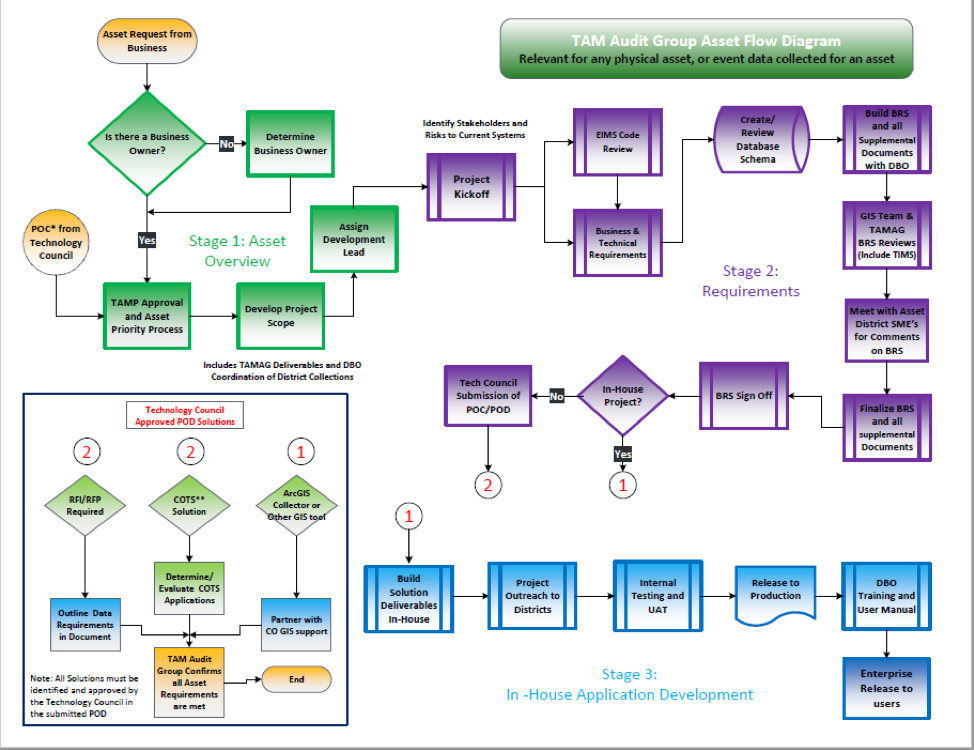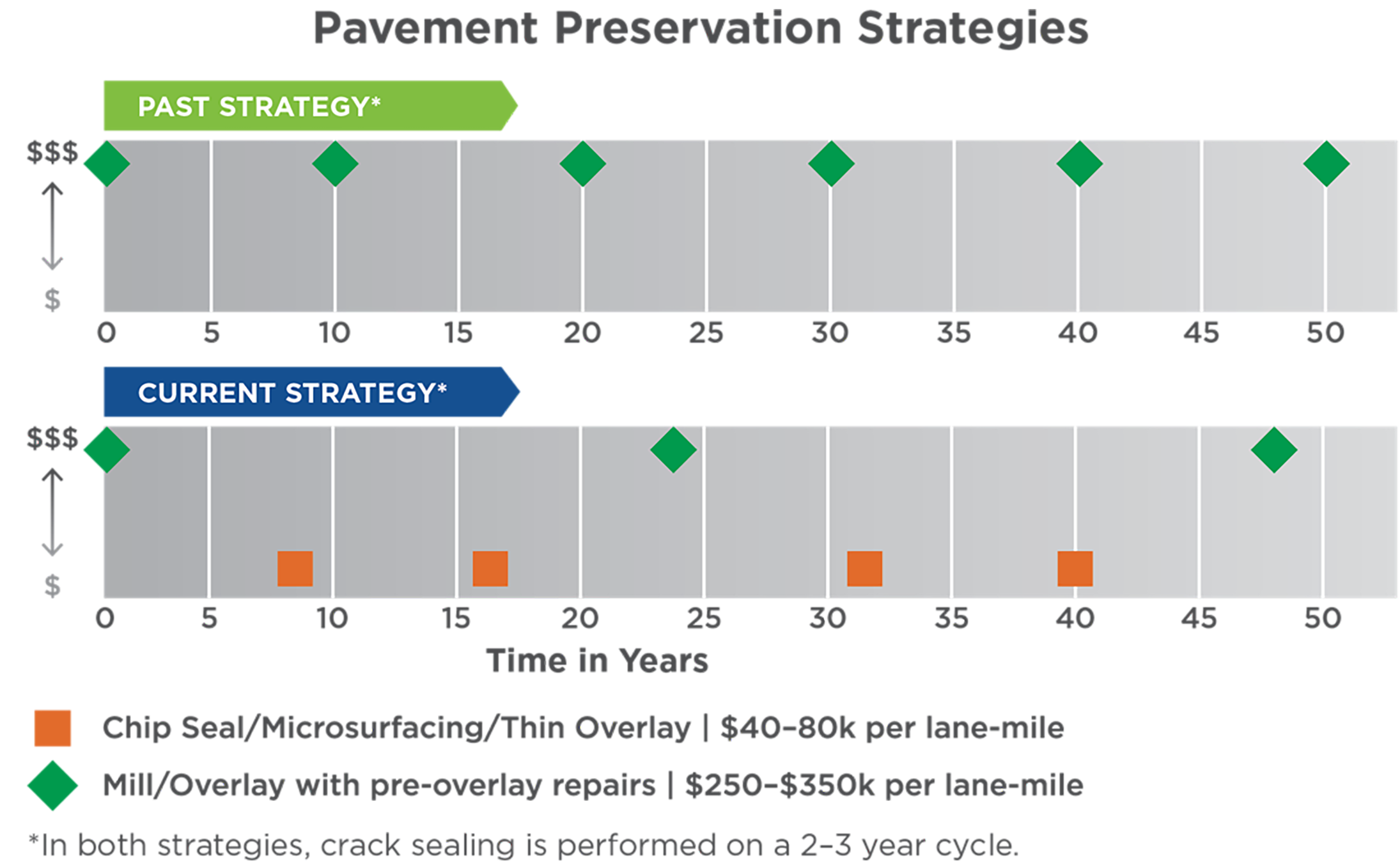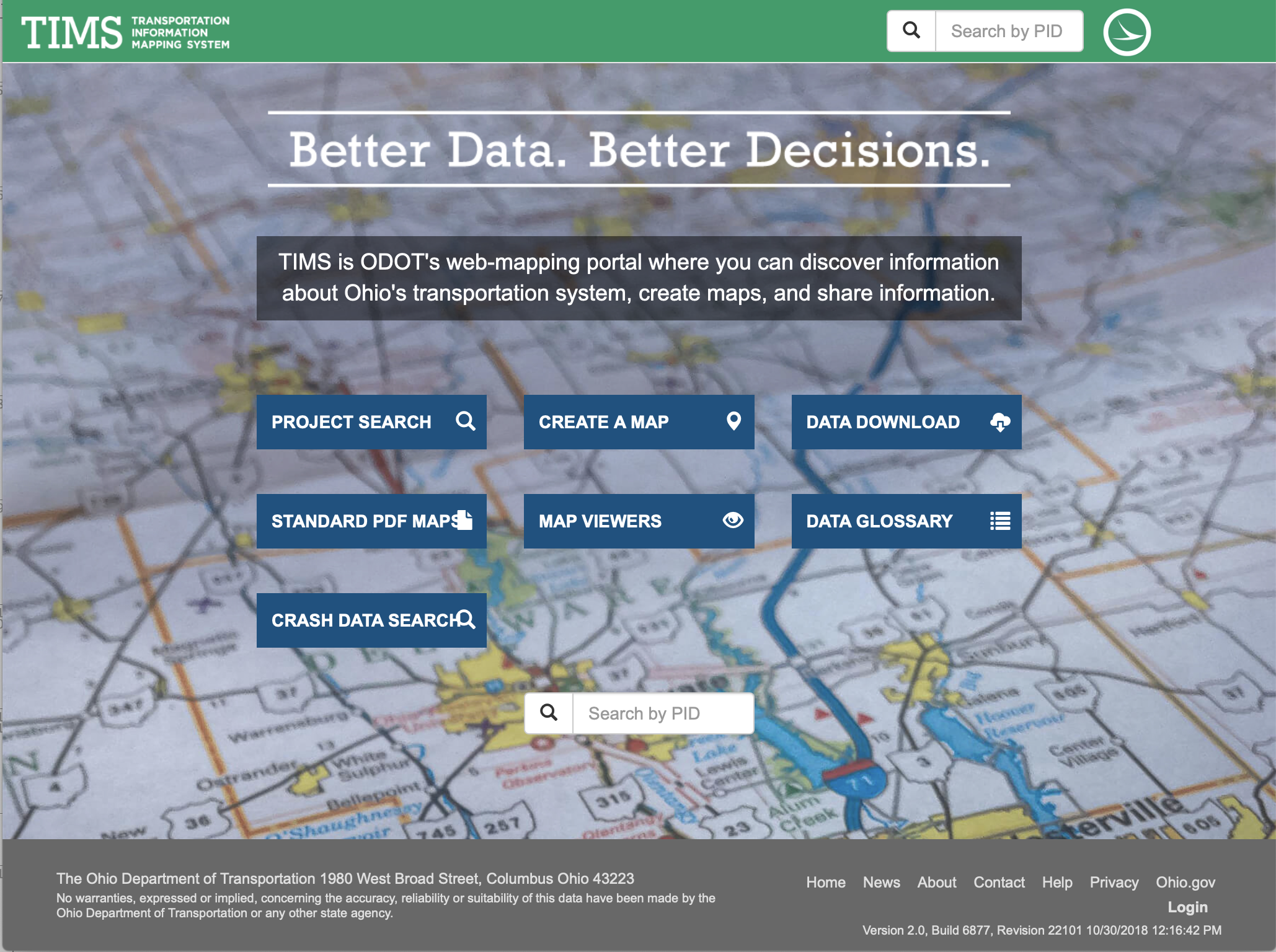Process for Adding New Asset Data
Ohio DOTOhio DOT has established a standard process for adding a new asset to their inventory. As illustrated in the flowchart below, the process has three stages – (1) Asset Overview, where the request is submitted, evaluated, and approved, (2) Requirements, in which business and technical requirements for collecting and managing the new data are documented, and (3) Application Development, where the technology solution is developed either in-house (using standard tools), via contract (for custom development) or through acquisition of a commercial off-the-shelf (COTS) package.
As part of the TAM Audit Group workflow shown in the figure, ODOT has introduced over 693,000 active ancillary assets into their inventory.
Ohio DOT TAM Audit Group Workflow Diagram
Source: Ohio DOT. 2019
Read more in the chapter: 7.4.2 Data Governance Practices Supporting TAMDefinition of Data-Driven Decision Making
Ohio DOTData-driven decision making can be defined as:
“An approach to business governance or operations which values decisions supported with verifiable data. The success of the data-driven approach is reliant upon the quality of the data gathered and the effectiveness of its analysis and interpretation”
Read more in the chapter: 7.3.3 Preparing Data for Sharing, Reporting and VisualizationIntegrating Asset and Project Information
Ohio DOTOhio DOT has separate pavement and structures management systems, but integrates both asset and project information within its Transportation Information Management System (TIMS). A separate Transportation Asset Management Decision Support Tool (TAM-DST) allows for a user to combine data from TIMS with other state-maintained data sets to perform analysis and reporting. The application allows for one to consume large quantities of data in a timely manner to help make better choices in planning. See practice examples in Section 2.2.4 and Section 6.2.1 for more information on TIMS.
Read more in the chapter: 7.1.2 Why Integrate?Asset Condition and Performance Information Mapping System
Ohio DOTThe Ohio DOT recognizes the importance of integrated management systems to support both life cycle and comprehensive work planning activities. One of the tools developed by the Ohio DOT is its Transportation Information Mapping System (TIMS), which enables planners, engineers and executives to access and manage key asset, safety and operational data in an integrated web-mapping portal (https://gis.dot.state.oh.us/tims). The portal is available to both internal and external stakeholders and allows users to access information about the transportation system, create maps or share information. The data integration efforts enabling TIMS are now underpinning all management system implementations.
Read more in the chapter: 6.2.1 Types of Performance-Based Data to MonitorUse of a Pavement Management System to Establish a Life Cycle Strategies
Ohio DOTAs required under MAP-21, Ohio DOT conducted a risk assessment to identify the most significant threats and opportunities to its pavements and bridges. The analysis revealed that anticipated flat revenues, combined with the annual increases in cost to pave roads and replace bridges, would lead to significant reduction in conditions without changes to existing practice. The potential deterioration in pavement and bridge conditions were expected to significantly increase future investment needs due to the increase in substantial repairs that would be required.
Following the risk assessment, a life cycle analysis was conducted. The analysis found that by focusing on the increased use of chip seals and other preventive maintenance treatments on portions of the pavement network, the annual cost of maintaining the network could be reduced. A life cycle analysis for bridges showed similar results. The bridge analysis found that with just 5 percent of the NHS bridges receiving a preservation treatment annually, the DOT could reallocate $50 million each year to other priorities. The investment strategies outlined in the TAMP and the changes made to the DOT’s existing business processes enabled the agency to offset the potential negative impact of the anticipated flattened revenue projections.
The differences in the adopted life cycle strategies are compared to the past strategies in the Figure. Although the total number of treatments applied over the analysis period increases, the annual life cycle cost decreases because of the reduction in the number of rehabilitation strategies needed.
Ohio DOT’s Pavement Preservation Strategy Comparisons
Source: Ohio DOT Transportation Asset Management Plan. 2018. http://www.dot.state.oh.us/AssetManagement/Documents/ODOT_TAMP.pdf
Read more in the chapter: 4.3.1 Managing Assets Using Condition Based ManagementTransportation Information Mapping System (TIMS)
Ohio DOTOhio DOT (ODOT) has focused on data and information management improvements as a foundational element of their asset management program. As part of this they have strengthened their geographic information system (GIS) and linked it to over 80 data sets. The agency’s TIMS allows users to make collaborative decisions based on shared access to the same data sets.
Source: Ohio DOT. TIMS.https://gis.dot.state.oh.us/tims/
Read more in the chapter: 2.2.4 Information ManagementChange Management Due to System Change
Ohio DOTIn fiscal year 2016, ODOT began phasing in new requirements for the development of District Work Plans that combined Capital and Maintenance projects. At that time, Districts’ Work Plans were required to match 25 percent of the lower cost treatments (such as chip seals and micro-surfacing) recommended by the pavement management system. For FY2017 and beyond, District Work Plans are required to match 75 percent of these PMS recommendations.
This change was met with concern by some district staff in regards to data quality in the PMS, and lack of familiarity with the new process. To address staff concerns, the Asset Management Leadership Team conducted workshops, bringing in staff involved in pavement programming from across the state. The workshop focused on actions that Ohio DOT could take to improve the PMS and its programming processes.
Read more in the chapter: 3.3.3 TAM Change ReadinessVideo and Media
Ohio DOTTaking Care of What We Have: A message that defines the benefits that TAM brings through tangible examples that are linked to the DOT objectives. Ultimately this inspires confidence in the approach and the TAM decisions being made.
Video: https://youtu.be/B6jZJQBvpc0
Read more in the chapter: 3.2.3 CommunicationTAM Data Collection
Ohio DOTThe Ohio DOT Asset Management Leadership Team is a cross-disciplined team, with representatives from all major business units, that establishes data governance and data collection standards. A sub-group of the Leadership Team, the TAM Audit Group, is then responsible for overseeing all asset data related requirements, and making sure standards are in place and processes are followed. This group reviews and approves all data collection efforts and ensures that efforts are coordinated across the DOT. Having designated roles and responsibilities in regards to data governance and collection allows the agency to identify all potential customers of the data being collected and ensure that the data is sufficient to meet all relevant asset management needs.
The Ohio DOT deploys a hierarchy for managing TAM data collection.
- TAM data priority is established by the Governance Board (Assistant Directors)
- The Asset Management Leadership Team (AMLT), which is a cross-discipline team of representatives from all major business units, develop strategies and collaboration opportunities to achieve Governance Board directives
- The TAM Audit Group (TAMAG) perform business relationship management by working with data business owners, SMEs, and stakeholders to create enterprise TAM data requirements
- The Central Office GIS team utilizes the completed TAMAG business requirements to create data collection solutions
- The District TAM Coordinators provide oversight, support and coordination for data collection solution implementation, operations and performance


